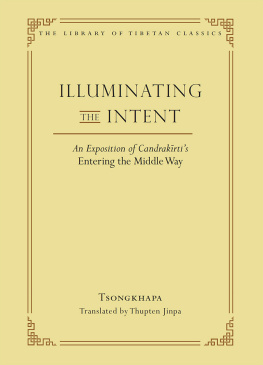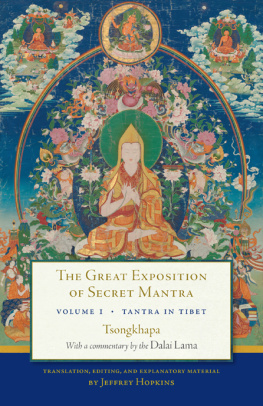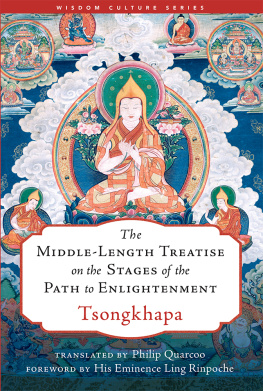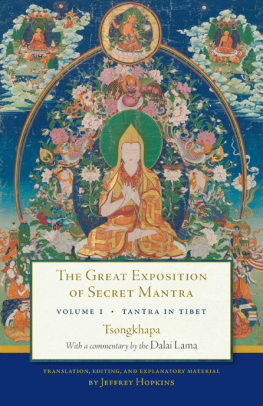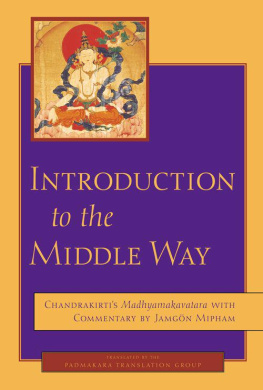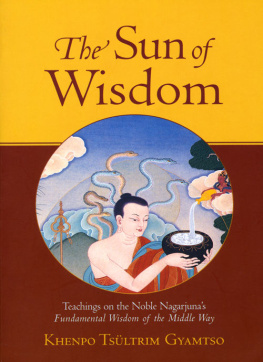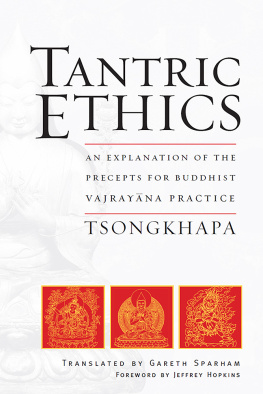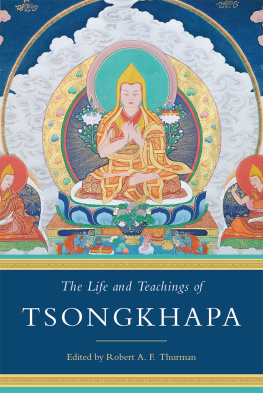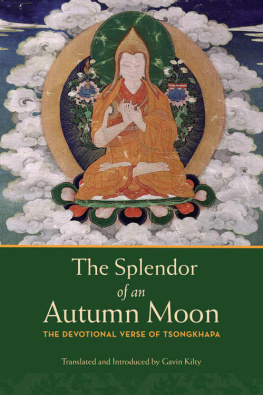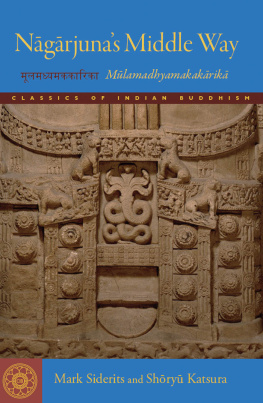The Library of Tibetan Classics is a special series being developed by the Institute of Tibetan Classics aimed at making key classical Tibetan texts part of the global literary and intellectual heritage. Eventually comprising thirty-two large volumes, the collection will contain over two hundred distinct texts by more than a hundred of the best-known authors. These texts have been selected in consultation with the preeminent lineage holders of all the schools and other senior Tibetan scholars to represent the Tibetan literary tradition as a whole. The works included in the series span more than a millennium and cover the vast expanse of classical Tibetan knowledge from the core teachings of the specific schools to such diverse fields as ethics, philosophy, linguistics, medicine, astronomy and astrology, folklore, and historiography.
Illuminating the Intent
An Exposition of Candrakrtis Entering the Middle Way
Tsongkhapa (13571419)
This work is an authoritative exposition of Candrakrtis seventh-century classic Entering the Middle Way. Written primarily as a supplement to Ngrjunas Fundamental Verses on the Middle Way, Candrakrtis text integrates the central insight of Ngrjunas thought the rejection of any metaphysical notion of intrinsic, objective being with the ethical and edifying elements of the Buddhas teachings. He undertakes this by correlating the progressive stages of insight into the emptiness of intrinsic existence with the well-known Mahayana framework of the ten levels of the bodhisattva.
Completed the year before the authors death, Tsongkhapas exposition of Candrakrtis text is recognized by the Tibetan tradition as the final standpoint of Tsongkhapa on many of the questions of Buddhist Madhyamaka philosophy. Written in lucid exemplary Tibetan, Tsongkhapas work presents a wonderful marriage of rigorous Madhyamaka philosophical analysis with a detailed and subtle account of the progressively advancing mental states and spiritual maturity realized by sincere Madhyamaka practitioners. The work is still used as the principal textbook in the study of Indian Madhyamaka philosophy in many Tibetan monastic colleges. Tsongkhapas extensive writings on Madhyamaka philosophy, including the present text, ushered in a new phase of engagement with the philosophy of emptiness in Tibet, giving rise to a great flowering of literary activity on the subject by subsequent Tibetan scholars like Gyaltsab J, Khedrup J, and the First Dalai Lama, as well as the critiques of Taktsang Lotswa, Gorampa, Shkya Chokden, and Karmapa Miky Dorj and the subsequent responses to these by Tsongkhapas followers, such as Jamyang Galo, Jetsun Chkyi Gyaltsen, and Panchen Losang Chgyen.

J Tsongkhapas Illuminating the Intent presents the enlightened meaning of Ngrjuna, Buddhaplita, Candrakrti, and ntideva, who clarify Lord Buddhas teachings on selflessness. It is famed for its clarity and for the depth of its decisive analysis of the difficult points of the view of emptiness. Gesh Thupten Jinpa has admirably applied his own years of study and thought to bring this precious work to English-speaking readers.
HIS EMINENCE LING RINPOCH
Illuminating the Intent is Tsongkhapas renowned commentary on Candrakrtis Entering the Middle Way, the foundational text for the study of Madhyamaka in Tibet. Composed in 1418, it is Tsongkhapas last exposition of Madhyamaka. Here he sets forth the meaning of emptiness in the context of the practice of the bodhisattva, delineating each of the ten perfections. Once again, we have Thupten Jinpa to thank for a masterful translation of a Buddhist classic.
DONALD LOPEZ, Arthur E. Link Distinguished University Professor of Buddhist and Tibetan Studies, University of Michigan
This volume is indispensable for understanding Tsongkhapas philosophical contributions.
JAY GARFIELD, Doris Silbert Professor in the Humanities, Smith College, and the Harvard Divinity School
Thupten Jinpas succinct introduction provides a wealth of information on the central issues raised in this important Tibetan commentary on the stages of the bodhisattva path. His skillful translation makes even Tsongkhapas lengthy treatment of the complexities of understanding emptiness clear and accessible.
KAREN LANG, professor emerita, University of Virginia, and author of Four Illusions: Candrakrtis Advice to Travelers on the Bodhisattva Path
I always look forward to any translation that Thupten Jinpa brings to publication. Not only does he have a masterful way of rendering a Tibetan text into very clear English, he brings to it a keen understanding of the meaning of the text that is derived from his broad education and rich cross-cultural experience. The reader can now confidently, as he says, engage with the text in an efficient and comprehensive manner.
JOSHUA CUTLER, editor of The Great Treatise on the Stages of the Path to Enlightenment

Message from the Dalai Lama
THE LAST TWO MILLENNIA witnessed a tremendous proliferation of cultural and literary development in Tibet, the Land of Snows. Moreover, due to the inestimable contributions made by Tibets early spiritual kings, numerous Tibetan translators, and many great Indian paitas over a period of so many centuries, the teachings of the Buddha and the scholastic tradition of ancient Indias Nland monastic university became firmly rooted in Tibet. As evidenced from the historical writings, this flowering of Buddhist tradition in the country brought about the fulfillment of the deep spiritual aspirations of countless sentient beings. In particular, it contributed to the inner peace and tranquility of the peoples of Tibet, Outer Mongolia a country historically suffused with Tibetan Buddhism and its culture the Tuva and Kalmuk regions in present-day Russia, the outer regions of mainland China, and the entire trans-Himalayan areas on the southern side, including Bhutan, Sikkim, Ladakh, Kinnaur, and Spiti. Today this tradition of Buddhism has the potential to make significant contributions to the welfare of the entire human family. I have no doubt that, when combined with the methods and insights of modern science, the Tibetan Buddhist cultural heritage and knowledge will help foster a more enlightened and compassionate human society, a humanity that is at peace with itself, with fellow sentient beings, and with the natural world at large.
It is for this reason I am delighted that the Institute of Tibetan Classics in Montreal, Canada, is compiling a thirty-two-volume series containing the works of many great Tibetan teachers, philosophers, scholars, and practitioners representing all major Tibetan schools and traditions. These important writings are being critically edited and annotated and then published in modern book format in a reference collection called The Library of Tibetan Classics, with their translations into other major languages to follow later. While expressing my heartfelt commendation for this noble project, I pray and hope that The Library of Tibetan Classics will not only make these important Tibetan treatises accessible to scholars of Tibetan studies, but will create a new opportunity for younger Tibetans to study and take interest in their own rich and profound culture. Through translations into other languages, it is my sincere hope that millions of fellow citizens of the wider human family will also be able to share in the joy of engaging with Tibets classical literary heritage, textual riches that have been such a great source of joy and inspiration to me personally for so long.

